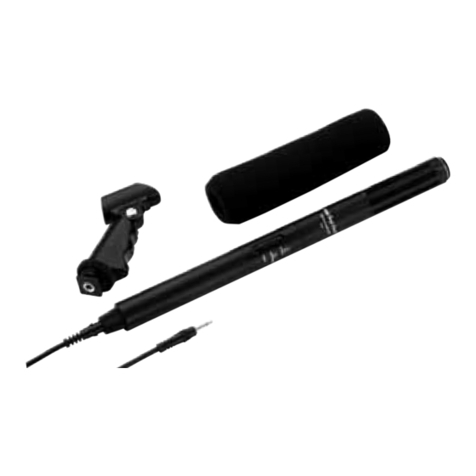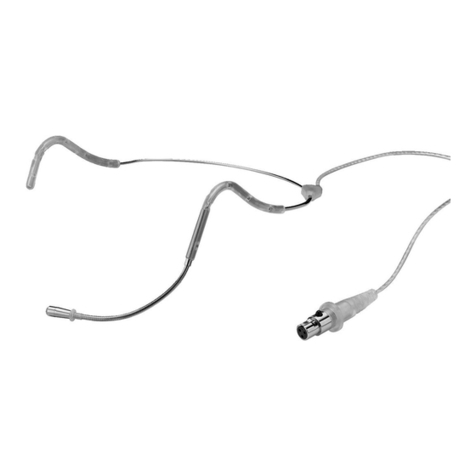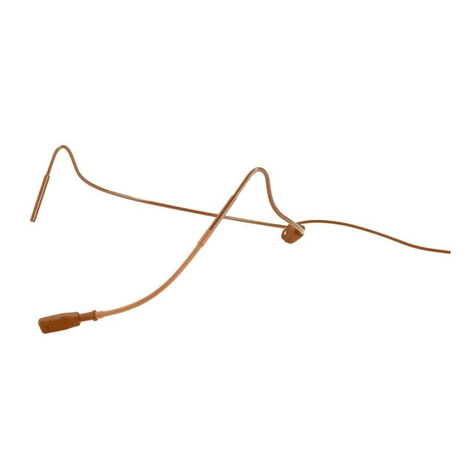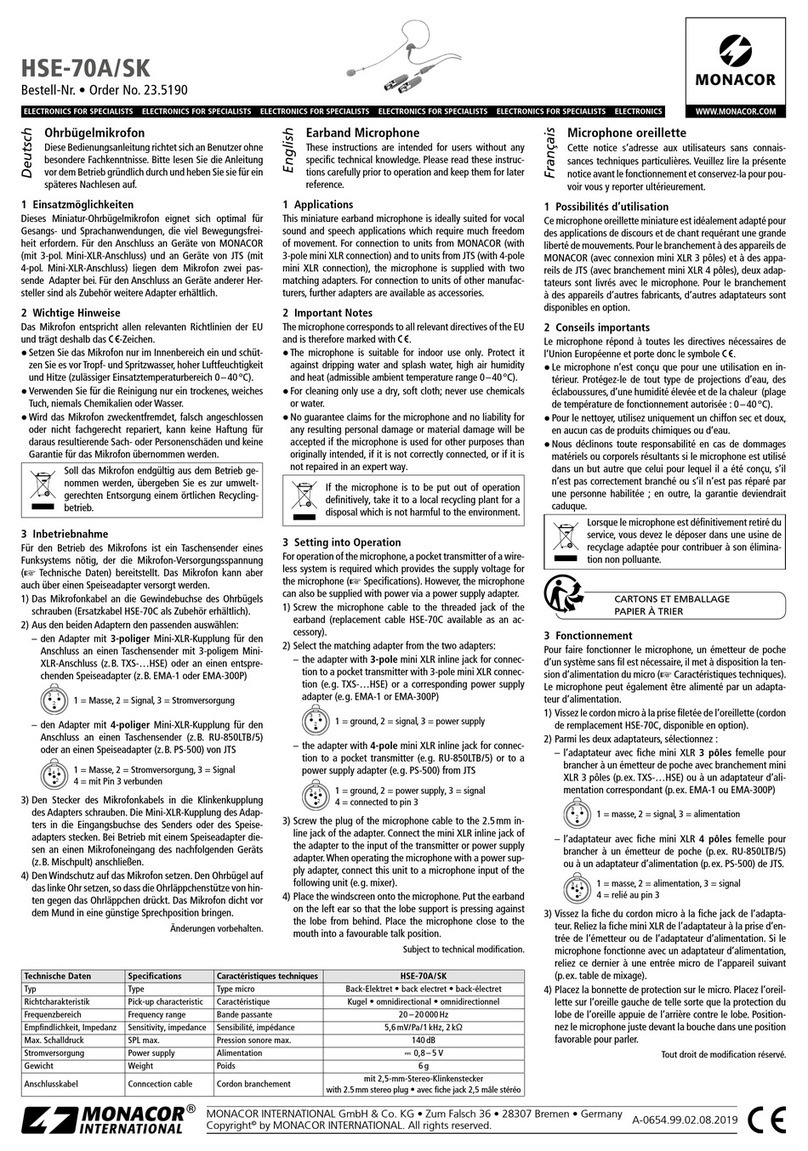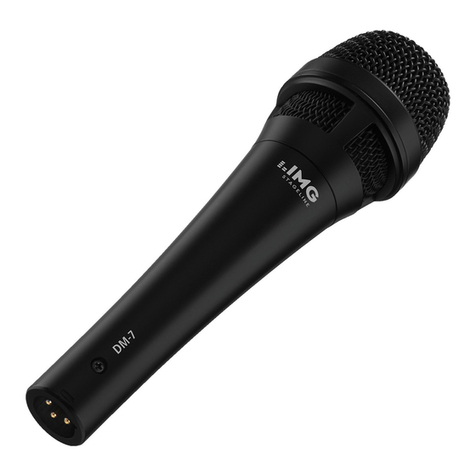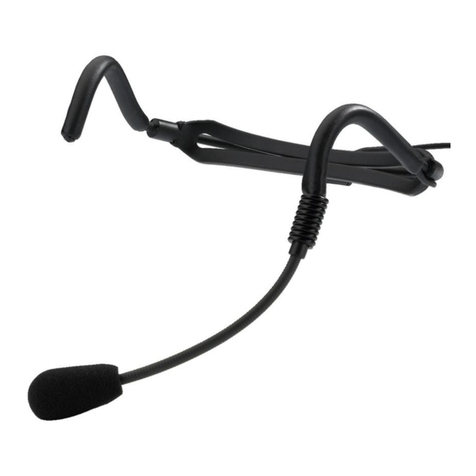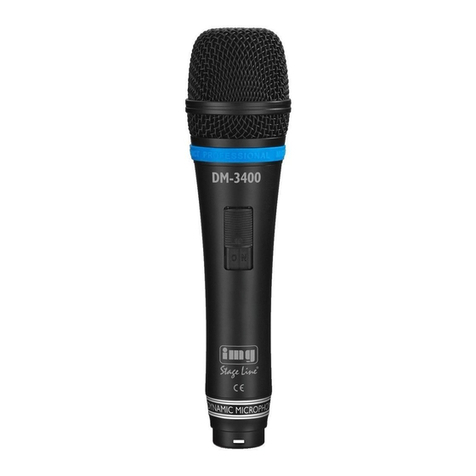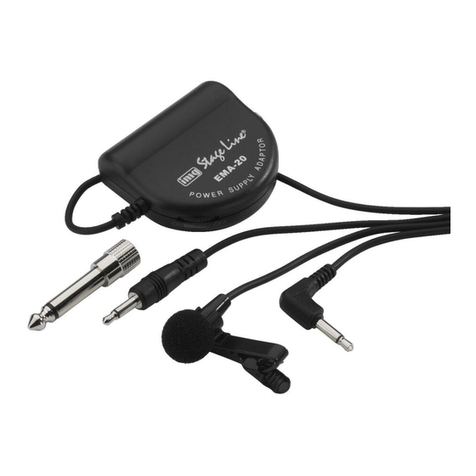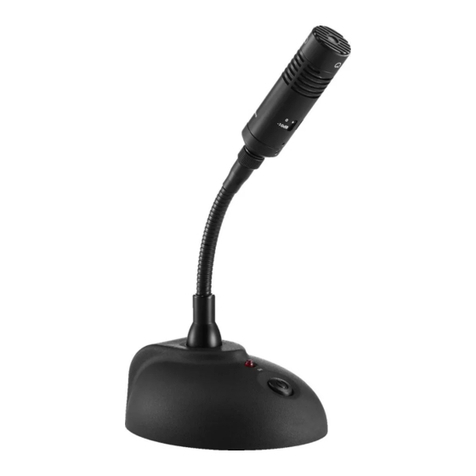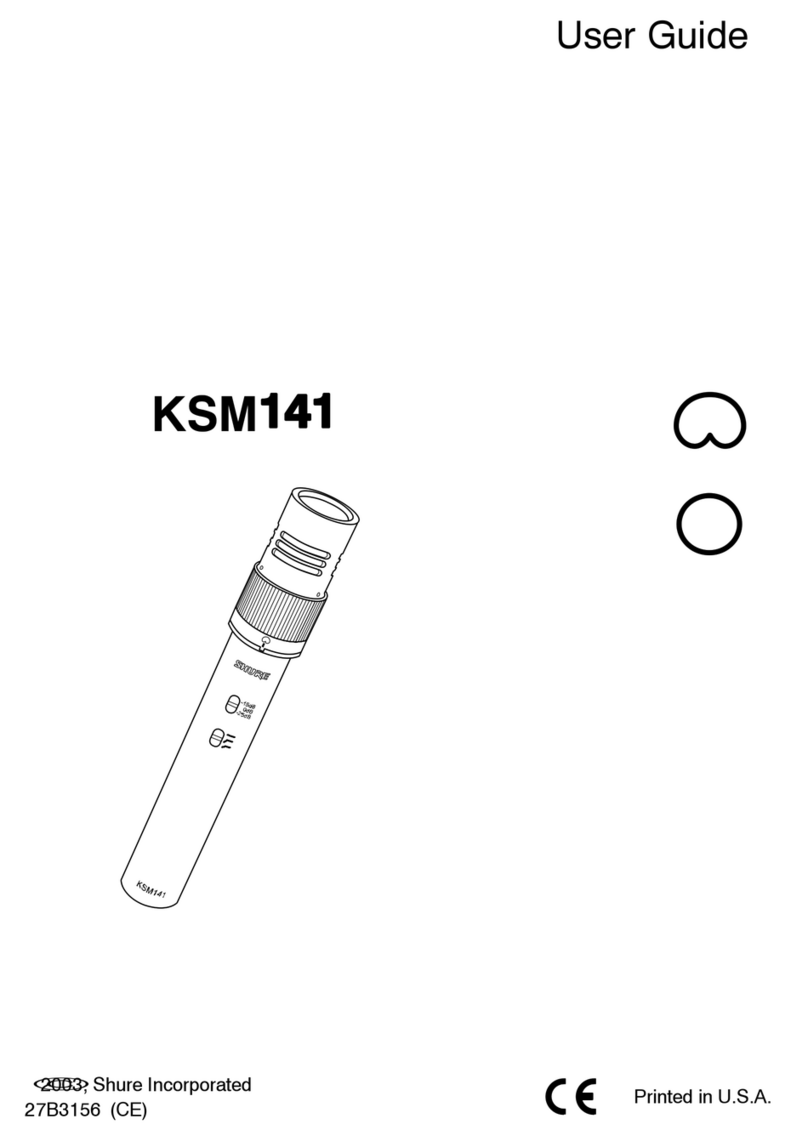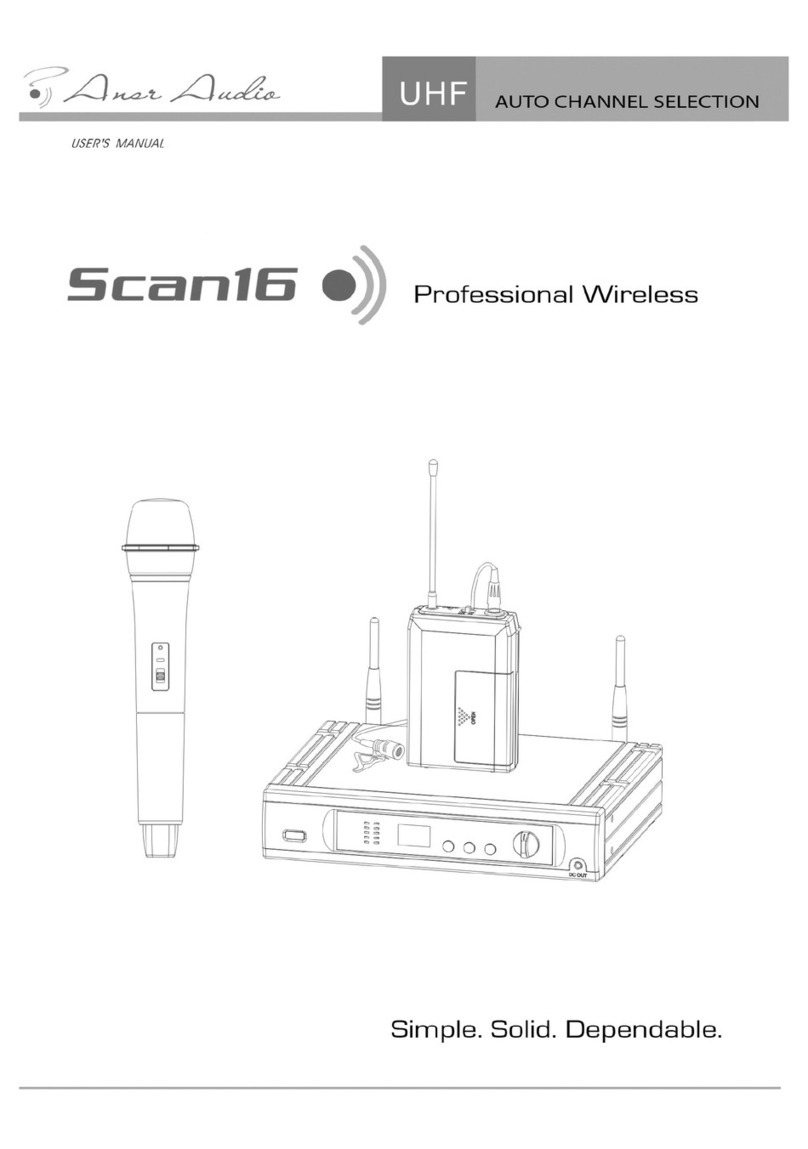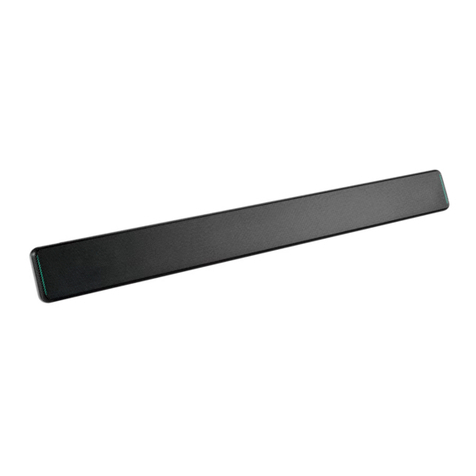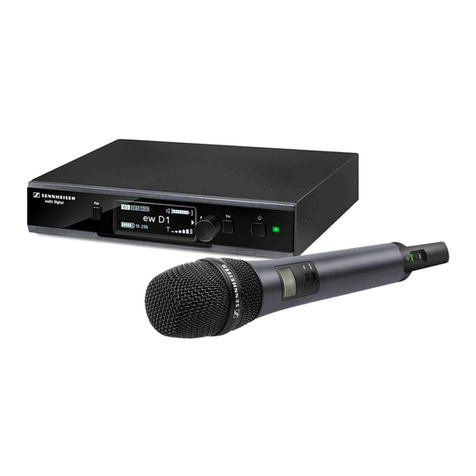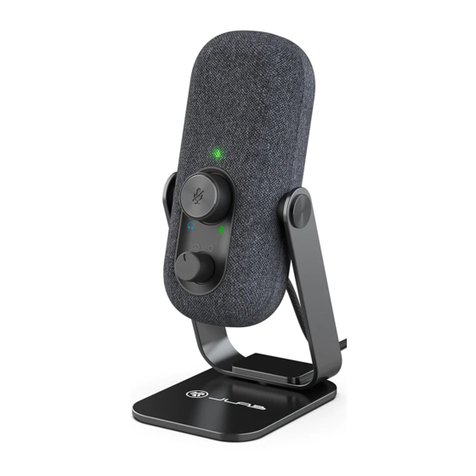
ELECTRONICS FOR SPECIALISTS ELECTRONICS FOR SPECIALISTS ELECTRONICS FOR SPECIALISTS ELECTRONICS FOR SPECIALISTS ELECTRONICS FOR SPECIALISTS ELECTRONICS
MONACOR INTERNATIONAL GmbH & Co. KG • Zum Falsch 36 • 28307 Bremen • Germany
Copyright©by MONACOR INTERNATIONAL. All rights reserved. A-0976.99.03.09.2018
0°
30°
60°
90°
120°
150°
210°
240°
270°
300°
330°
100
20 50 100 200 500 1k 2k 5k 10k 20k [Hz]
-
50
-
60
-
70
-
80
-
90
Microfono overhead
all’elettrete
Queste istruzioni sono rivolte a utenti con cono-
scenze base nella tecnica audio. Vi preghiamo di
leggerle attentamente prima dell’installazione e
di conservarle per un uso futuro.
1 Possibilità d’impiego
Il microfono all’elettrete è previsto per l’impiego
professionale sul palcoscenico e nello studio di regi-
strazione ed è indicato in modo ottimale per la ripro-
duzione di strumenti musicali (p.es. come microfono
overhead per piatti, hi-hat) nonché per il canto e la lin-
gua parlata. A scelta, il microfono può essere alimen-
tato da una batteria 1,5V oppure dall’apparecchio
audio collegato (alimentazione phantom 9–48V).
Ha in dotazione un supporto con filettatura
16mm (5⁄8”) equipaggiato con un adattatore con
filettatura 9mm (3⁄8”) nonché. In dotazione c’è anche
un cavo di collegamento di 6m.
2 Avvertenze di sicurezza
Il microfono è conforme a tutte le direttive rilevanti
dell’UE e pertanto porta la sigla .
•
Usare il microfono solo all’interno di locali e pro-
teggerlo dall’acqua gocciolante e dagli spruzzi
d’acqua, da alta umidità dell’aria e dal calore (tem-
peratura d’impiego ammessa fra 0 e 40°C).
•
Per la pulizia usare solo un panno morbido,
asciutto; non impiegare in nessun caso prodotti
chimici o acqua.
•
Nel caso d’uso improprio, di collegamenti sbagliati,
o di riparazione non a regola d’arte del microfono,
non si assume nessuna responsabilità per eventuali
danni consequenziali a persone o a cose e non si
assume nessuna garanzia per il microfono.
Se si desidera eliminare il microfono defini-
tivamente, consegnarlo per lo smaltimento
ad un’istituzione locale per il riciclaggio.
Non gettare le batterie scariche nei rifiuti di casa
bensì negli appositi raccoglitori.
3 Messa in funzione
1) Se l’ingresso microfono dell’apparecchio audio
non è equipaggiato con un’alimentazione phan-
tom 9–48V(⎓), montare una batteria 1,5V del
tipo mignon (AA): svitare la parte bassa del mi-
crofono in senso antiorario ed inserire la batteria,
rispettando la corretta polarità (vedi sovrastampa
nel vano batteria). Riavvitare la parte svitata.
Se il microfono non viene utilizzato per un
tempo prolungato conviene togliere la batteria
per evitare danni se la batteria perde.
2) Avvitare il supporto del microfono sul treppiede.
Se il treppiede è con filettatura 16mm (5⁄8”), svitare
l’adattatore dal supporto ed avvitare il supporto
direttamente sul treppiede. Se il treppiede è con
filettatura 9mm (3⁄8”) usare l’adattatore per il fis-
saggio. Inserire il microfono nel supporto.
3) Collegare il microfono con un ingresso microfono
XLR dell’apparecchio audio (p.es. mixer, amplifi-
catore).
4) Per accendere il microfono spostare l’interruttore
da “OFF” (spento) su “ON”.
4 Dati tecnici
Tipo: � � � � � � � � � � � � � � microfono all’elettrete
Caratteristica: � � � � � � � a cardioide
Banda passante: � � � � � 80 – 15 000Hz
Sensibilità:� � � � � � � � � � 5mV/Pa a 1kHz
Impedenza: � � � � � � � � � 400Ω
Pressione sonora max�: 115dB
Alimentazione: � � � � � � batteria 1,5V mignon (AA)
oppure alimentazione phantom
9– 48V (⎓)
Temperatura d’impiego:
0 –40 °C
Dimensioni:� � � � � � � � � ⌀26/24mm × 195mm
Peso:� � � � � � � � � � � � � � 110 g
Collegamento:� � � � � � � XLR, simmetrico
Con riserva di modifiche tecniche.
ECM-285
Référence num. • Codice 23.2760
Microphone électret overhead
Cette notice s’adresse aux utilisateurs avec des
connaissances techniques de base en audio.
Veuillez lire la présente notice avec attention
avant le fonctionnement et conservez-la pour
pouvoir vous y reporter ultérieurement.
1 Possibilités d’utilisation
Le micro électret ECM-285 est conçu pour une utili-
sation sur scène et en studio et est idéal pour la prise
de son d’instruments (p. ex. comme micro overhead
pour cymbale ou hi-hat) et pour les applications de
discours et chant. Il peut, au choix, être alimenté par
une batterie 1,5V ou de manière externe via l’appa-
reil audio relié (alimentation fantôme 9–48V).
Le micro est livré avec un support avec filetage
16mm (5⁄8”), y compris une vis d’adaptation avec file-
tage 9mm (3⁄8”), et un câble de branchement de 6m.
2 Conseils importants
Le microphone répond à toutes les directives néces-
saires de l’Union Européenne et porte donc le sym-
bole .
•
Le microphone n’est conçu que pour une utilisation
en intérieur. Protégez-le de tout type de projections
d’eau, des éclaboussures, d’une humidité élevée et
de la chaleur (plage de température de fonctionne-
ment autorisée : 0–40°C).
•
Pour le nettoyer, utilisez un chiffon sec et doux, en
aucun cas de produits chimiques ou d’eau.
•
Nous déclinons toute responsabilité en cas de
dommages matériels ou corporels résultants si le
microphone est utilisé dans un but autre que celui
pour lequel il a été conçu, s’il n’est pas correcte-
ment branché ou s’il n’est pas réparé par une per-
sonne habilitée ; en outre, la garantie deviendrait
caduque.
Lorsque le microphone est définitivement
retiré du service, vous devez le déposer
dans une usine de recyclage adaptée pour
contribuer à son élimination non polluante.
Ne jetez pas directement les batteries usagées dans
la poubelle domestique, ramenez-les à un contai-
ner spécifique (p.ex. un collecteur chez votre re-
vendeur).
3 Fonctionnement
1) Si l’entrée micro à laquelle le micro doit être relié
n’est pas équipée d’une alimentation fantôme
9–48V(⎓), insérez une batterie 1,5V de type
R6 : dévissez le couvercle (partie inférieure) en le
tournant dans le sens inverse des aiguilles d’une
montre et insérez la batterie dans le compartiment
en respectant la polarité (notée dans le comparti-
ment). Revissez le couvercle du boîtier.
En cas de non utilisation prolongée, veillez à
retirer la batterie : si elle viendrait à couler, elle
peut endommager le micro.
2) Vissez le support micro livré sur un pied pour
micro: si le pied dispose d’un filetage 16 mm (5⁄8”),
retirez la vis d’adaptation du support et vissez di-
rectement le support. Si le pied a un filetage 9mm
(3⁄8”), fixez le support via la vis d’adaptation. Placez
le micro dans le support.
3) Branchez le micro à une entrée micro XLR de l’ap-
pareil audio (p.ex. table de mixage, amplificateur).
4) Pour allumer le micro, mettez l’interrupteur sur
«ON»; en position «OFF», le micro est déconnecté.
4 Caractéristiques techniques
Type : � � � � � � � � � � � � � microphone électret
Directivité : � � � � � � � � � cardioÏde
Bande passante :� � � � � 80– 15 000 Hz
Sensibilité : � � � � � � � � � 5mV/Pa à 1kHz
Impédance : � � � � � � � � 400 Ω
Pression sonore max� : � 115dB
Alimentation : � � � � � � � batterie 1,5V (type R6) ou ali-
mentation fantôme 9– 48V (⎓)
Temp� d’utilisation : � � � 0 – 40°C
Dimensions : � � � � � � � � ⌀26/24mm × 195mm
Poids :� � � � � � � � � � � � � 110 g
Branchement :� � � � � � � XLR symétrique
Tout droit de modification réservé.
Italiano
Réponse en fréquence • Risposta in frequenza Diagramme polaire • Diagramma direttivo
Français
CARTONS ET EMBALLAGE
PAPIER À TRIER
